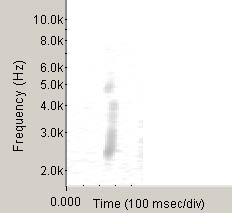Here are some common sounds made by Norway rats.
A note about spectograms: A spectogram is a visualization of a sound. Along the horizontal axis is time, and the vertical axis is frequency, or pitch, which is measured in Hertz (Hz). The intensity, or loudness, of a sound corresponds to the darkness of the spectogram at that point. Cornell has a more detailed explanation of spectograms. I have included spectograms of each sound below. Spectograms are used a lot in studies of animal communication (for more, go to the Cornell Lab of Ornithology or the Borror Lab of Bioacoustics).
So, a wolf-whistle sound (play sound). has this spectogram:
![]() (click on the thumbnail to get a bigger picture). In the table below, click on the thumbnail below each sound to
view its sonogram.
(click on the thumbnail to get a bigger picture). In the table below, click on the thumbnail below each sound to
view its sonogram.
Note: you may need to turn your volume up very high to hear these soft vocalizations. External speakers may also help.
|
Vocalization |
Exemplar |
Longer example |
|
Peep
|
Snip peeps while Cricket grooms his head. |
Play Sound (452K) Snip peeps several times in a row while Cricket grooms his head. |
|
Short Squeak
|
Play Sound (64K) Short squeak by Snip during head grooming. |
Play Sound (136K) Cricket and Snip are both in a tube hammock, and one of them squeaks twice. |
|
More short squeaks... |
Play Sound (44K) Widget gives "chevron-shaped" squeak during altercation with Snip. |
Play Sound (156K) Widget squeaks during altercation with Snip |
|
Chirrup
|
Play Sound (64K) Squeak chirrups while Cricket grooms his head. |
|
|
Squeak-Churr
|
Play Sound (60K) Snip squeak-churrs during grooming by Cricket |
Play Sound (56K) Snip squeak-churrs during altercation with Widget |
|
Long Squeak
|
Play Sound (72K) Snip long squeak |
Play Sound (332K) Several long squeaks in a row by Snip |
|
Play Sound (188K) Three long squeaks by Snip during intense altercation with Widget |
||
|
Broken Long Squeak
|
Play Sound (64K) Broken squeak by Snip, during grooming. |
|
|
Shriek
|
Play Sound (52K) Double shriek by Widget, during petting when he didn't want to be petted.
|
Play Sound (636K) Long squeaks, broken long squeaks, squeak-churrs, then shrieks from Widget during an attempt to give him medicine orally by syringe (no, he wasn't hurt, just furious). After this, I found a food-med mixture that he ate voluntarily, which was easier on everyone! |
|
Hiss
|
||
|
Brux
|
Play Sound (440K) Short sequence of Cricket bruxing |
30 sec sequence of Cricket bruxing. (2.2MB) 30 sec sequence of Snip bruxing. (1.8MB) Bruxing sequence (1.0 MB). Bruxing by rat named Celia. Reproduced here with the kind permission of Angelrats of Rat Tales. |
|
Chatter
|
Play Sound (184K) Widget chatters during agonistic encounter with Snip |
Longer sequence of Widget chattering (652K)
Longer sequence of Widget chattering, with simultaneous ultrasonic vocalizations by Snip (436K) Snip's USVs in (2) are the faint horizontal lines at the very top of the image |
|
Distress Ultrasonic Vocalization
|
Snip emits series of USVs during intense nose-off with Widget. USVs are the faint horizontal lines along top edge of sonogram, just above 20 kHz. inaudible to human ears |
|
|
More sounds to come as I am able to record them! |
Materials and methods: To record these sounds, I used a digital microphone (Labtec Verse 704) set up near the cage. The microphone's recording range is 100 Hz - 16 kHz, and its sensitivity is: -67 dBV/uBar, -47 dBV/uBar +/-4 db. The recordings have a 44 kHz sample rate, a 16 bit audio sample size, and there is just one channel (mono). Recordings were made less than 5 feet away from the rats, with the distance varying from a few inches to several feet.
I recorded directly into a computer. I used AudioX for the Mac OS X, a recording program, to record some of the sounds, then switched to SpectraPLUS for the PC, a signal analysis program, to record more sounds and create spectrograms. Lastly, I used Felt Tip Sound Studio for the Mac to increase the volume and reduce some of the low frequency noise on the softer sounds (peeps and short squeaks).
Here are Cricket and Snip getting ready to record. Later, here is Cricket bruxing into the microphone.





